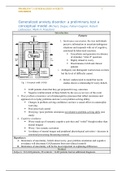Samenvatting
Block 2.6. Anxiety & Stress: Problem 7 GAD(Generalized Anxiety Disorder) English Summary
Block 2.6. Anxiety & Stress: Problem 7 GAD(Generalized Anxiety Disorder) English Summary Summary of everything discussed in the tutorials and the literature, The grade obtained for the course was 8.1
[Meer zien]




